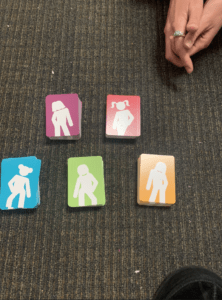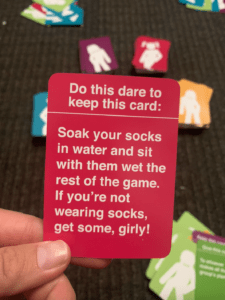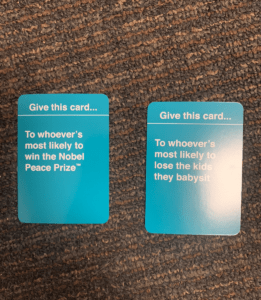For my critical play I chose the social card game For the Girls. It is manufactured by What do You Meme LLC. The main mechanics are simply just cards, a multisided multicolored die, and any number of people between 3 and 20 (this will add an aspect to the dynamics later). It is definitely made for ages 17-18+ due to the vulgarity of some cards and the life experience one has had to have before being able to relate to enough cards. Like my prototype, it is aimed at helping people get to know each other better in a funny, lighthearted and competitive way. Unlike my prototype, and perhaps its slight downfall, is that it is really only for people that know each other really well, and the dynamics of the game can be excluding for certain groups of people. Obviously, it is called “For the Girls” and stays true to the girly theme, which is done very well, but I think there could be some areas of improvement to enhance the types of fun it tries to accomplish.
Something I really liked about this game was the design and simplicity of play. The text on the box is in simple pink neon letters, with a simple description in clean white below. There is plenty of space inside the box itself so that cards can easily be taken out and put back in. The only differentiator between cards are starkly different colors that match the sides of the die. When I played, my friends and I didn’t even have to read the instructions and we already knew how to play.
I think these simple mechanics that lead to the dynamics of getting into game play quickly and the ability to make turn taking fast and easy really adds to the Fellowship type of fun that it creates. No one has to argue about any of the cards or their rules because they are all self explanatory, which leaves a lot more room for chatting and just playing the game.
Another notable mechanic of the game was the different color cards having different categories. This created a couple different types of fun, but also in my opinion leads to some exclusionary practices that I think could be worked on. There are dare cards, cards to keep if you have done the action written on them, category game cards, cards to give to a person that it describes the best, and cards to give to a person that would “totally do” the thing (sight red flag).
Both the dare and category cards added an extra element of Challenge to the game by tasking players to compete. If you complete the dare, you keep the card, and if you lose the category game, you give up the card. The point of losing the card seems to add to the objective of “the person who gets 25 cards first wins” (slight red flag #2). Some of the dares were personal, like “let someone text a person on your phone and then delete it,” but some were just funny and uncomfortable like this one:
A note on that picture: I just really like the aesthetic of the simple, bright colorful cards everywhere. I like it better than the simple black and white of Cards Against Humanity because it just looks more fun. The girls on the fronts are also so sassy which I just love and adds to the girly theme so much better to me than something like hearts or pictures of makeup would. They actually elicit femininity without being stereotypical, which I like. In my game we are modeling our cards based on this color based system to hopefully get that same fun effect.
Moving on to the red flags I mentioned earlier. The category of cards that require you to give it to someone who would “totally do that” could definitely exclude people and expose potential abuses. If someone is given that card as a joke, I can see it being really hurtful, especially if it doesn’t align with that person’s values. For example:
The first card is cute and complimentary, and the second card isn’t even really as bad as some other ones, but if someone were to give that card to me I would be very very upset because of my personal history. I am really really passionate about becoming a great mom, so if someone were to give me this card insinuating that I am not good with kids it would be really hurtful. There are many other cards like this that could potentially make people feel these kinds of things, but there are also more lighthearted and funny ones that I think are a lively aspect of the game. A solution for this could be to just get rid of potentially consequential cards, even if this means the number in each deck is uneven. I don’t know who out there is counting exactly how many cards are in these huge decks anyway, and it would seem like a beneficial tradeoff to me. This is something that I want to carry forward in my own prototype. If there is a card that might make people too uncomfortable to the point of getting hurt, I will be more than happy to have an uneven deck than cause that to happen.
The second red flag is the objective. For groups of people that know each other very well, this is not really much of a problem because it is funny and obvious when certain cards get handed out to certain people. However, when the group doesn’t know each other very well, the allocation of cards could be really screwed up. For example, if you are in two different friend groups and they are both playing, those friend groups will probably only be able to assign those cards to the people they actually know. Writing this out now I can see this being good for getting to know people, but there is also that tradeoff of possibly exposing personal details that you might not want people you don’t know that well to find out. The same goes for the cards you keep if you have done what is written on them. You want to win so you want to keep the card, but if it is embarrassing or exposing you may not want to keep it.
Overall, I think this game is very aesthetically pleasing and exciting, and a lot of fun if you are very close with the people you are playing with, but I think there are some areas of improvement to avoid specific abuses.







